Allegro
Local 802 Heritage: Trekking Through a Century of Files (part 2)
Volume 122, No. 11December, 2022
This is Part Two of my exploration into Local 802 heritage by way of some noted members’ membership applications. As stated in these pages last month, I’ve been working with the 802 administration and Executive Board on plans for an eventual public exhibit at the local’s building. This will include historic photos and archival forms, not the least of which are membership applications. The latter’s relevance lies not only as a document of a given musician’s entry and/or reinstatement into the union, but something of a biographical sketch.
In this month’s edition, we will review applications from the very famous (Leonard Bernstein) to less renowned greats who were major forces in music’s development (Elmer Snowden and Don Byas) as well as members who well-represented women (Viola Smith), modern classical music (Elie Siegmeister), among others. As before, this month’s entries are listed here in the chronological order of their application for membership.
ELMER SNOWDEN (1900-1973), jazz banjoist and guitarist, hailed from Baltimore and founded the Washingtonians which featured the arrangements of its pianist Duke Ellington. Snowden brought the band to New York in 1923, creating a popular home base in Harlem. In addition to this band, he fronted numerous other aggregations which boasted the leading jazz musicians of the day. After Ellington took control of the Washingtonians, Snowden recorded with the likes of Bessie Smith, and toured with various musicians who’d mature into stars including Roy Eldridge and Big Sid Catlett. His career dimmed for some decades during which time he had disputes with this union (due to his longstanding issue of non-payment of dues), but was rediscovered in the late’50s and recorded the now legendary Harlem Banjo album and was celebrated at the 1963 Newport Jazz Festival. Within the Local 802 archives, we have Snowden’s original application from November 1924 as well as multiple reinstatement forms through 1937.
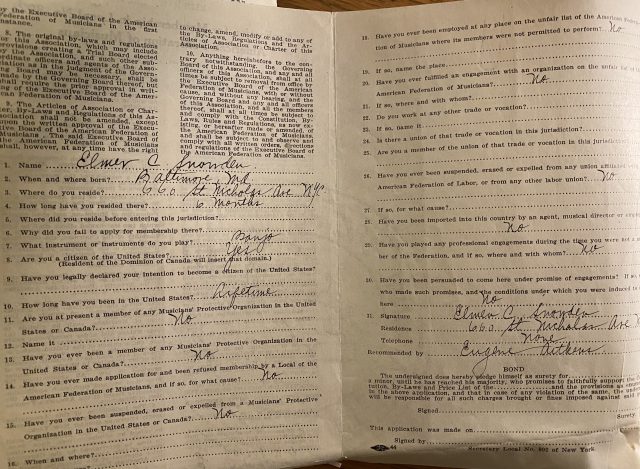
Elmer Snowden
ADOLPHUS “DOC” CHEATHAM (1905-1997) was born in Nashville and was initially set in a track to become a pharmacist, hence the nickname, but exposure to jazz brought him into music with a passion. Though a trumpet player of major import early on, he also performed as a saxophonist while in southern vaudeville circuit and in the accompaniment of blues singers. After moving to Chicago in the early 1920s, then the hotbed of jazz development, Cheatham was exposed to both King Oliver and then the youthful Louis Armstrong newly transplanted from New Orleans, learning firsthand from these giants. His career as a first-call soloist began in this period and he carried this into New York, where he landed in 1931. The years, unfortunately, haven’t been kind to Cheatham’s application. Torn and held together with yellowed scotch tape, this historic document verifies his status as “travel” originating in Chicago prior to his move here. Cheatham’s storied career includes work with Chick Webb, Benny Carter, Perez Prado, Benny Goodman, Teddy Wilson, Machito and a host of others.
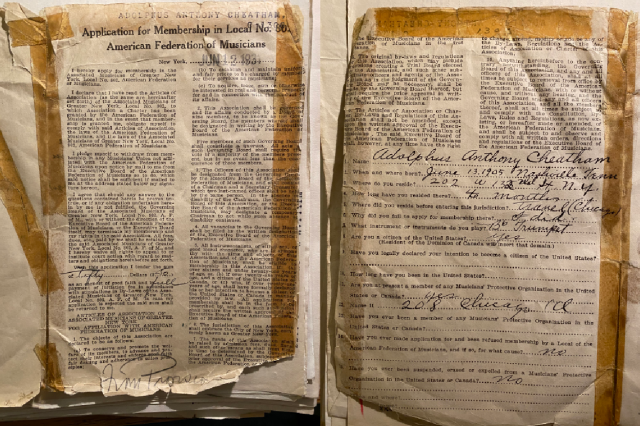
Doc Cheatham
DON BYAS (1912-1972) was born in Muskogee, Tennessee and began classical music study of both violin and clarinet, but ultimately settled on tenor saxophone, an instrument with which he would successfully bridge early swing music into modern jazz. Initial work with Benny Moten and Walter Page led to some years in Los Angeles where he worked with Lionel Hampton’s band. By 1937, however, Byas relocated to New York, engaging in performance and record dates in bands led by Billie Holiday, Don Redman and Andy Kirk. By 1941 he’d joined Local 802, listing his instruments as “saxophone and clarinet,” in time to take over the highly coveted tenor seat in Count Basie’s band. Concurrently, he became a regular musician at Minton’s Playhouse, a site that would become legendary as the birthplace of be-bop. In 1944 and ‘45 he was on the sessions that produced “Woody n You” and “Salt Peanuts,” often cited as the first bebop recordings, in the company of Dizzy Gillespie, Oscar Pettiford, Max Roach and others. Byas moved to Europe and performed almost exclusively there through the rest of his life.
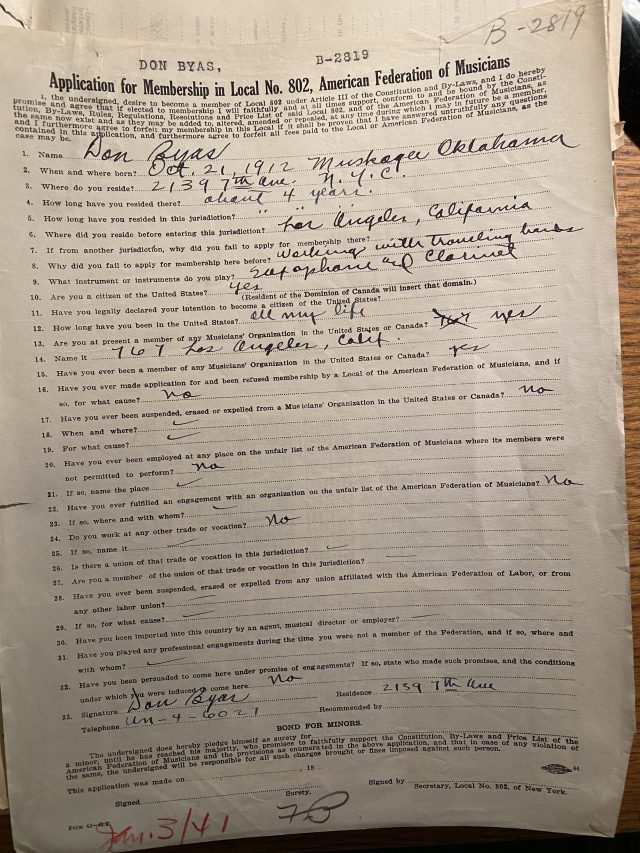
Don Byas
VIOLA SMITH (1912-2020) was a groundbreaking female drummer in a time when women were continually oppressed by the male-led music industry. As a child, she and several sisters studied music and formed an all-girl ensemble which toured on the vaudeville circuit and came to prominence on radio. In 1938, Viola and sister Mildred, saxophonist, founded a professional all-female band, the Coquette Orchestra which toured successfully into 1942. That year she penned an article for Downbeat advocating for the hiring of women musicians to replace the many male musicians who’d joined armed service bands for the war effort. In this period, she relocated to NYC, took tutelage with legendary percussionists Saul Goodman and Billy Gladstone and studied at Julliard. In the following years, Smith performed with that conservatory’s symphony as well as the National Orchestra Association and was among the many jazz musicians playing 52nd Street venues. She was also seen in numerous television appearances and in film. Smith was also the drummer in the original production of “Cabaret” on Broadway. Known as “the female Gene Krupa,” she played a drumkit with six tom-toms including two high up on stands. Even through oppressive gender bias, Smith maintained an important and varied career. She was featured in Allegro in 2013 and again in 2019.
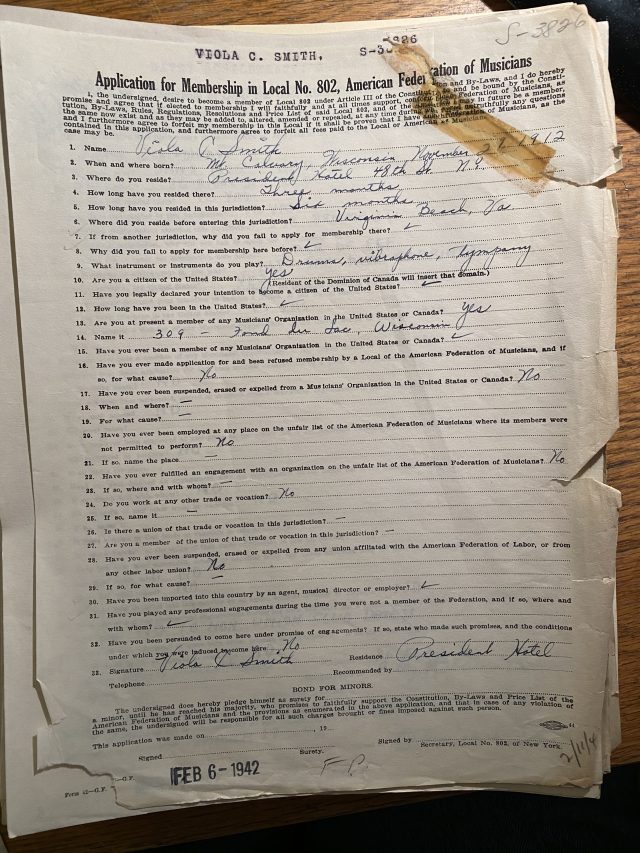
Viola Smith
ELIE SIEGMEISTER (1909-1991) was born in Manhattan and raised in Brooklyn. He began studying piano at age five and, shockingly, entered Columbia University at 15, graduating cum laude three years later, but also studied at Julliard with esteemed composer Wallingford Rieger. He then traveled to Paris to study composition under Nadia Boulanger, befriending Virgil Thomson and Aaron Copland there. Following his return home, Siegmeister engaged in modern music composition and performance, moving within the broad left-wing circle of musicians who’d soon form the Composers Collective of New York. Among his output in this period is “Strange Funeral at Braddock” to poetry of Michael Gold. The Composers Collective worked to promote modern composition with strong social activist messaging, performing at union halls and community centers, seeking to cast an American proletariat music. He also championed the concept of folk forms within concert music and published several books of folk music including, in 1935, Negro Songs of Protest. A prolific composer, Siegmeister ultimately wrote nine operas and nine symphonies as well as countless other works, many premiered by notable conductors Stokowski, Toscanini, Mitropoulos and others. Among his song-cycles were a collection of 50 to the poetry of Langston Hughes. He also composed sweeping works to the major speeches of Dr. Martin Luther King Jr. Siegmeister was instrumental in the creation of many social conscious organizations in the arts and maintained his overt progressive views throughout his life.
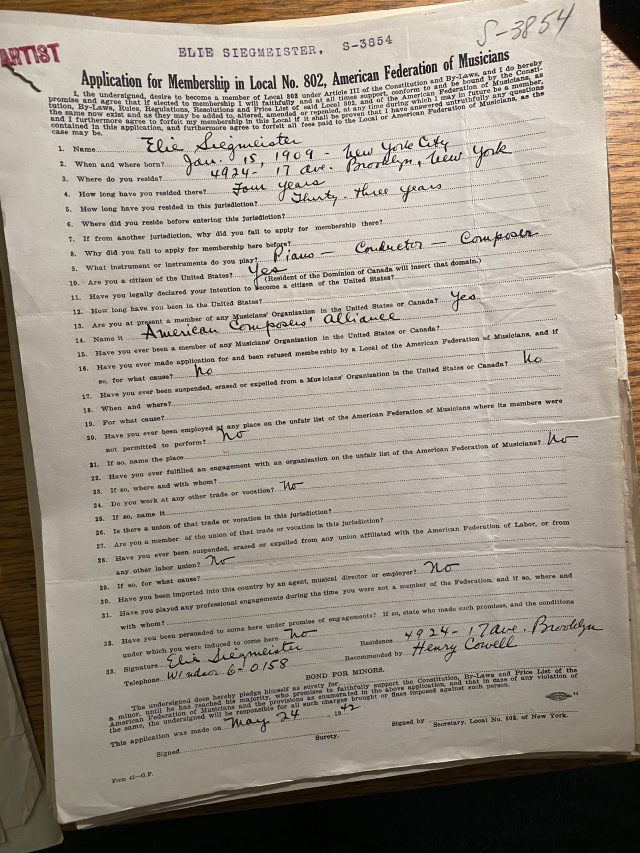
Elie Siegmeister
LEONARD BERNSTEIN (1918-1990) is perhaps the most celebrated conductor-composer in the canon of American music. Born in Lawrence, Massachusetts (itself the site of a vastly important mill strike in 1912), Bernstein studied piano as a child and quickly took to orchestral music. At the age of 14, he attended a concert of Arthur Fiedler’s Boston Pops which made a profound impact on his life; among the material was Ravel’s “Bolero”. In 1935 he became a student at Harvard, studying with Edward Burlingame Hill and Walter Piston, serving as accompanist to the Harvard Glee Club, performing numerous contemporary pieces and staging a production of Marc Blitzstein’s “Cradle Will Rock”, among other credits. By the early ‘40s, Bernstein was living in New York and engaged in a wide array of activities from piano playing to composition and, in 1943, conducting, joining Local 802 in April of that year as a pianist (he’d included “conducting” on the application and then crossed it out). His baptism by fire was with none other than the renowned New York Philharmonic, taking over the baton for an ailing Artur Rodzinski with scant notice, and drawing international praise. Bernstein’s credits number far too many to list here, but in the ensuing decades he was a beloved figure in the music, not only as the premiere conductor with the Phil for many years, but as the founder of a vital series of children’s concerts. His compositions range from “Symphony Number 3: Kaddish” (1963, in memory of President Kennedy) and “Mass: A Theatre Piece for Singers, Players, and Dancers,” to “On the Town,” and “West Side Story.”
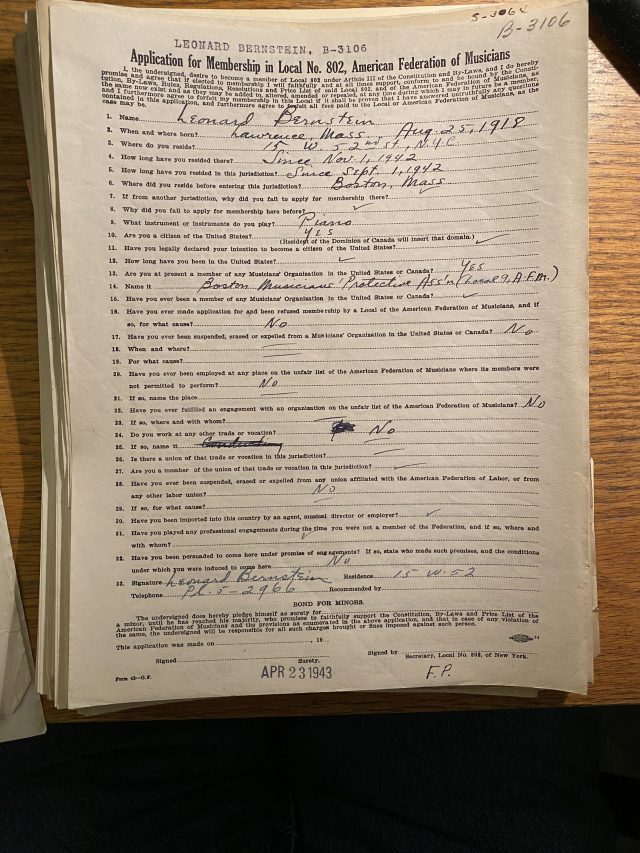
Leonard Bernstein
Next month we will continue this fascinating archeological dig into the wondrous heritage of Local 802.
